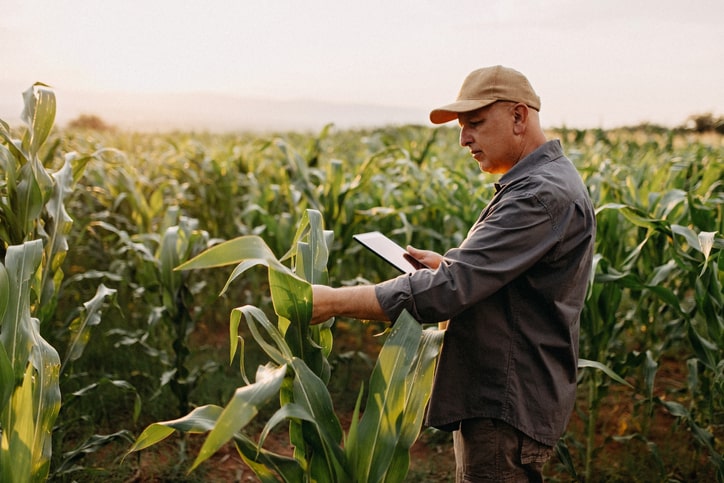09-24-2020 |
Producers Receive Additional Relief for 2020 Crop Year with CFAP 2
By: BrownWinick

The USDA released a Final Rule to announce the second round of the Coronavirus Food Assistance Program (CFAP 2) on Friday, September 18, 2020. Applications will be accepted through county FSA offices from Monday, September 21 through December 11, 2020, or until the allocated $14 billion runs out. So, what’s CFAP 2, and how does it compare to CFAP 1?
High-Level Details
The CFAP 2 payment calculator goes a long way in helping producers calculate their payments, but a high-level summary is warranted. CFAP 2 divides eligible farm commodities into three different categories—price trigger commodities, flat-rate crops (specialty crops), and sales commodities. Note, contract growers are not eligible for CFAP 2 payments.
- Price Trigger Commodities – Includes hogs, cattle, corn, soybeans, wheat, and dairy.
- Beef cattle – Payment rate is $55 per head (excluding breeders) x maximum inventory on a date selected by the producer from 4/15/2020 through 8/31/2020.
- Hogs and pigs – Same as beef cattle, but payment rate is $23 per head.
- Corn – Payment rate is the greater of:
- $15 per acre x eligible acres (excluding prevented planting and experimental acres); or
- $0.58 per bushel x eligible acres x 40% marketing percentage x 2020 Actual Production History approved yield.
- If APH yield is not available, use 85% of the county APH benchmark yield.
- Soybeans – Same as corn, but use a marketing percentage of 54%.
- Flat-rate Crops – These crops either did not experience a 5% price decline in 2020 or national data was not available. Generally, most specialty crops are included in the flat-rate crop category. Hemp is included as a flat-rate crop in CFAP 2.
- Payments for flat-rate crops are $15 per acre x eligible acres (excluding prevented planting and experimental acres).
- Sales Commodities – Include aquaculture, nursery crops, wool, and is a catch-all category for other crops.
- Payments for sales commodities use 2019 production data multiplied by a payment factor determined by sales revenues (ranging from 10.6 for small producers to 8.8 for sales over $1 million).
Differences from CFAP 1
CFAP 2 is designed to provide dollars to agricultural producers (including more generous benefits for row crop farmers) to offset increased marketing costs in 2020 due to the coronavirus pandemic. While many aspects of CFAP 1 are present in the second-round program, there are key differences, including:
- CFAP 2 generally uses 2020 production, legal ownership, and owner sweat equity to calculate payments. This applies to both row croppers and livestock producers.
- CFAP 1 used 2019 production for row crop farmers and 2020 Q1 inventories for livestock producers.
- CFAP 1 focused on 2019 legal ownership and 2019 “active participation” by owner/operators.
- Additional crops and livestock were added to the eligible commodities list. So, if you didn’t qualify for CFAP 1, you should double check the list of eligible commodities on the USDA website.
- Livestock producers were the big winners in CFAP 1. Livestock producers continue to receive payments in CFAP 2, but row crop producers will be benefitted much more than they were in CFAP 1. Many farmers had sold their 2019 grain prior to the coronavirus pandemic and thus received reduced (or no) benefits from CFAP 1.
- Eligible producers will receive 100% of their benefits immediately from their local FSA office once their application is approved.
- CFAP 1 paid producers 80% initially, with the remaining 20% paid after a certain period from the initial payment.
Similarities to CFAP 1
CFAP 2 retains many of the eligibility requirements and payment caps from CFAP 1, including the $900,000 AGI limitation for owners, active participation requirement (400 hours of farming or supervision), and maximum payment limitations (producers can’t receive multiple benefits and entity-level maximum payments are capped at $250,000, $500,000, and $750,000). From a planning perspective, if you added more legal owners to your farming operation prior to August 2020, your maximum payment may have increased since CFAP 1.
Get Help
Navigating another government program isn’t a high priority for producers, especially during the fall harvest (and upcoming hunting seasons). Contact attorney Colin Hendricks for assistance in navigating this program.
Additional details can be found on the USDA’s “facts and questions” page, the USDA’s upcoming webinar (September 24 at 2 p.m. CDT), and your local FSA office to help with your application.
